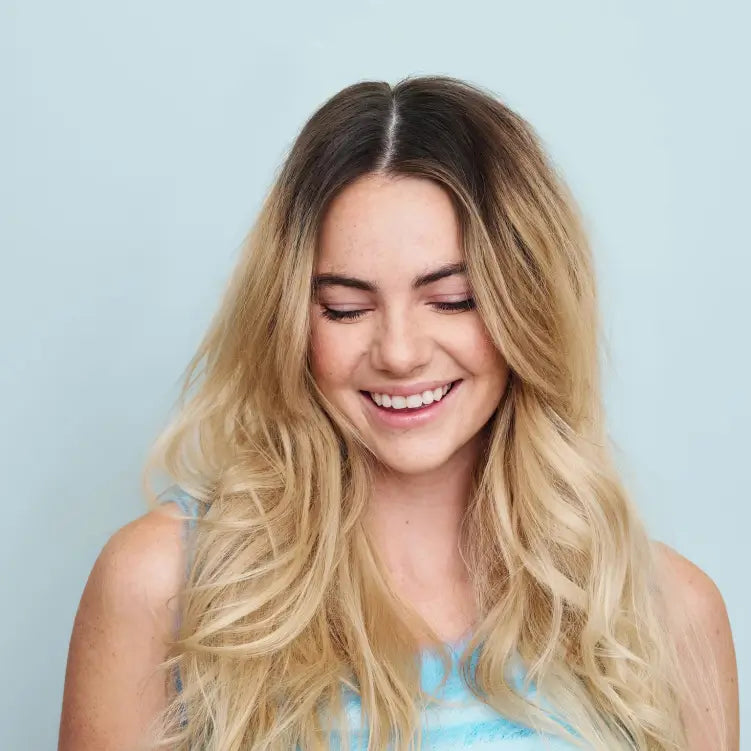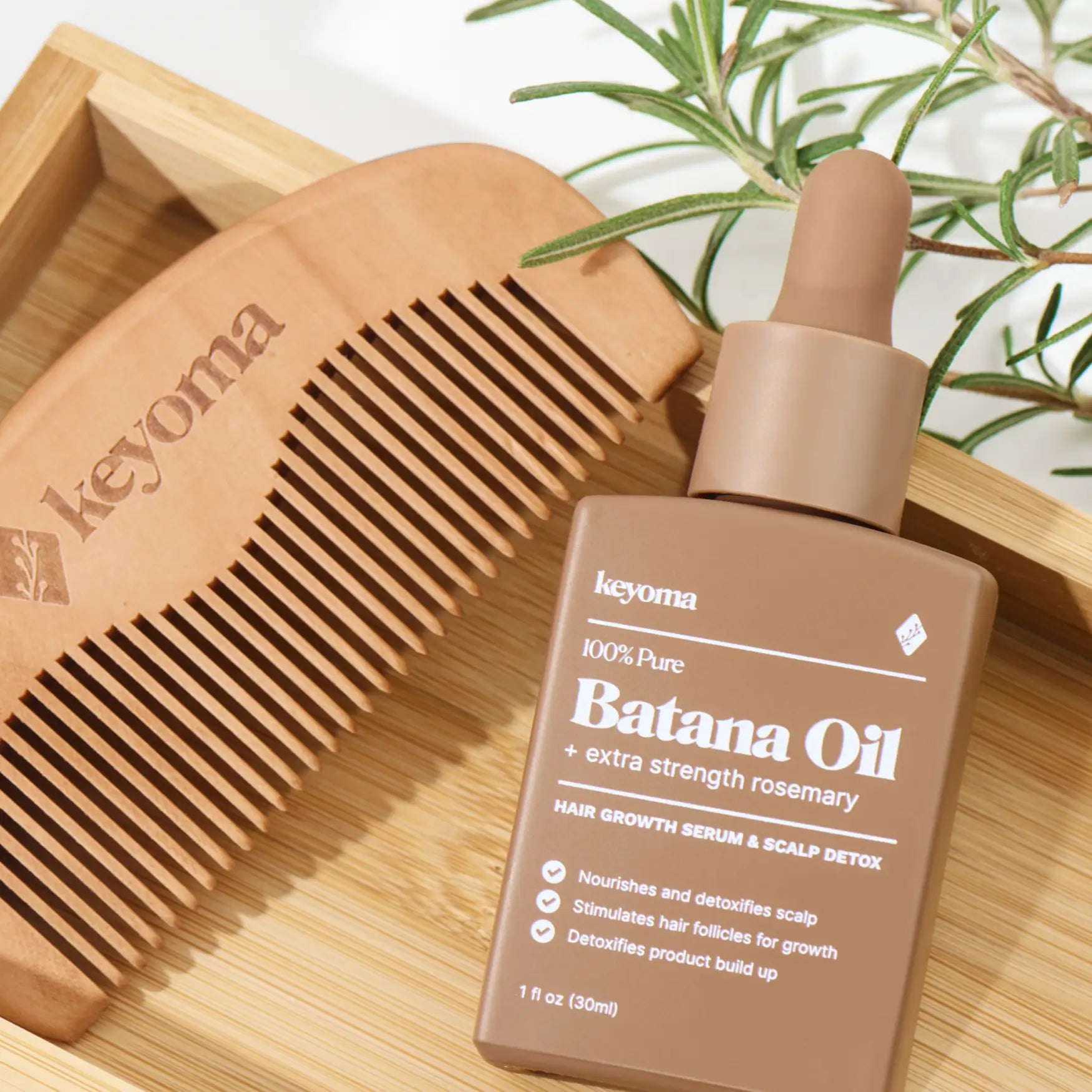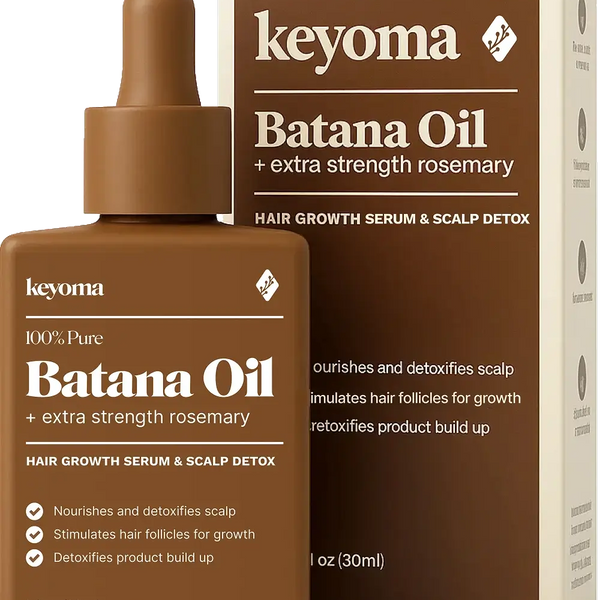In this article
Hydrate and moisturize are two of the biggest buzzwords in the hair care world, used so often that everyone thinks they mean the same thing.
Sure, they’re closely connected (after all, what’s moisture or hydration without water?), but technically, they each have their own job: one focuses on bringing water in, while the other locks it in to keep your strands soft and balanced.
In this guide, we’ll unpack the difference between hair hydration vs moisturizing, how to tell what your strands really need, and how to combine the two for hair that stays soft, healthy, and hydrated from the inside out.
What's the Difference Between Hair Hydration and Moisturizing?
Hair hydration focuses on drawing water into the hair shaft, while moisturizing focuses on sealing that water in so it doesn’t evaporate.
Hydration works at a deeper, more internal level. Humectants like glycerin or aloe vera act like magnets, pulling water molecules toward the cortex through the cuticle layer.
Moisturizing, on the other hand, strengthens the outer layer using emollients and sealants (like natural oils or butters) to lock in that hydration and reinforce the hair’s protective barrier.
That said, because each plays its own role in keeping hair healthy, it’s not an either-or situation. The two work best together, one complementing the other for lasting softness and strength. We’ll get into how to combine them later on.
Understanding Hair Hydration
Hair hydration is all about restoring and maintaining your hair’s internal water balance. When you think of hydration, imagine the inner core of your hair (the cortex) soaking up water molecules that travel through the cuticle, the outermost protective layer.
This movement happens when humectants such as glycerin, hyaluronic acid, aloe vera, and honey draw moisture from the air or from water-based formulas directly into the hair shaft.
Once absorbed, the keratin proteins inside the cortex bind to this moisture, improving elasticity and flexibility. This shows in hair that feels bouncy, soft, and naturally shiny.
Signs That Your Hair Needs Hydration
Hydration issues stem from what’s happening inside the hair shaft, specifically, when the cortex isn’t getting enough water or can’t retain it. Below are signs to know if your hair needs hydration:
-
Limp, lifeless texture: Hair that feels flat and lacks bounce often signals low internal moisture.
-
Dry but soft ends: When your strands feel dry yet still pliable, it’s a sign of dehydration rather than oil loss.
-
Increased static and flyaways: Lack of internal moisture leaves hair more porous and electrically charged, which shows up as frizz and static cling.
-
Hard-to-style or dull hair: If styling products seem ineffective or your hair won’t hold shape, it usually means the cortex isn’t hydrated enough to stay flexible.
-
Faster product absorption: Hydration-poor hair tends to soak up water or leave-ins quickly because the cortex is trying to drink in every drop.
How to Hydrate Your Hair
True hydration starts with water-based care and techniques that help that water travel past the cuticle and into the hair shaft. Below are ways to hydrate your hair:
-
Start with a gentle, sulfate-free cleanser: Use a hydrating shampoo formulated with humectants like glycerin or panthenol. Wash 2–3 times per week depending on buildup.
-
Apply a water-rich conditioner: After shampooing, use a conditioner that lists water or aloe vera as its first ingredient. Leave it on for 3–5 minutes to let humectants bind to the cortex.
-
Use a deep hydration mask weekly: Choose one infused with hyaluronic acid, honey, or amino acids. Apply from mid-length to ends, cover with a shower cap, and let it sit for 15–20 minutes before rinsing.
-
Try the LHC method (Liquid–Humectant–Cream): Spritz hair with water, then layer a light humectant-based leave-in spray before sealing with a mild emollient cream. This approach boosts water intake while maintaining flexibility.
-
Incorporate steam or heat caps occasionally: Warmth opens the cuticle slightly, helping humectants penetrate deeper. Limit to once a week to avoid overhydration.
-
Balance your environment: Use a humidifier if you live in dry climates. Proper air moisture helps humectants draw in water instead of pulling it from your hair.
Hair Hydration Products/Ingredients: What to Use and What to Avoid
Hydrating your hair starts with using the right ingredients that pull and hold water within the strands, but just as important is knowing what to stay away from. Here’s a closer look at what works and what can work against you.
What to Use:
-
Glycerin: A humectant that attracts water molecules from the air and channels them into the hair shaft, keeping the cortex hydrated and flexible. Works best in moderate humidity.
-
Aloe Vera: Rich in polysaccharides and amino acids, aloe vera binds moisture to the cuticle while soothing the scalp. It offers hydration without heaviness.
-
Hyaluronic Acid: A moisture magnet that holds up to 1,000 times its weight in water, drawing hydration deep into the cortex and improving strand elasticity.
-
Honey: Natural humectant that seals light hydration into the hair shaft while adding shine. It also helps smooth rough cuticles for a softer texture.
-
Panthenol (Pro-Vitamin B5): Penetrates the hair shaft and binds to keratin, increasing water retention and improving overall resilience.
What to Avoid or Use with Caution:
-
Heavy Silicones: Ingredients like dimethicone can coat the hair so tightly that they block humectants from drawing water into the cortex. Over time, this can lead to dryness beneath the shine.
-
Drying Alcohols: Alcohol denat, isopropyl alcohol, and similar forms evaporate quickly, pulling moisture out of your strands as they dry.
-
Sulfate-based Shampoos: Sodium lauryl sulfate and sodium laureth sulfate strip away both natural oils and water, disrupting the hair’s natural moisture balance.
-
Hard Water Residue: Minerals like calcium and magnesium form deposits that make the cuticle less permeable, preventing proper hydration. Using a chelating shampoo once or twice a month can help combat this.
-
Overuse of Protein Treatments: Too much protein without moisture balance can make hair rigid and prone to breakage. Hydration should always come first.
Understanding Hair Moisturizing
Hair moisturizing focuses on the outer protection of the hair, specifically the cuticle, sealing in the water already absorbed through hydration and preventing it from escaping.
When you apply moisturizers, emollients like shea butter, batana oil, jojoba oil, or avocado oil coat the hair shaft lightly, smoothing down raised cuticle scales. This creates a soft, flexible barrier that keeps water locked inside the cortex.
Sealants, such as castor oil or beeswax, go a step further by forming a more occlusive layer that slows evaporation even in dry environments.
To be clear, this process does not add new moisture. Rather, it protects the hydration your hair already has. It’s why moisturizing is always the second step after hydrating.
Signs That Your Hair Needs Moisture
When your hair struggles to stay smooth even after conditioning, it may not be losing water but rather the oils and lipids that trap it in. Here’s how to know if your hair needs moisturizing:
-
Rough, brittle texture: The cuticle is raised or damaged, making strands feel coarse or straw-like when touched.
-
Persistent frizz: When the outer layer can’t seal properly, water vapor in the air enters and swells the hair, creating unwanted frizz.
-
Split ends and breakage: Lack of surface oils weakens the protective layer, causing mechanical damage and fraying over time.
-
Dull or matte appearance: A smooth cuticle reflects light, while one that’s dry and lifted scatters it, resulting in a lack of shine.
-
Product build-up but no softness: You apply creams or oils, yet your hair still feels stiff.
How to Moisturize Your Hair
As if it hasn’t been emphasized enough, the principle of moisturizing your hair comes down to one thing: water alone isn’t enough. Once the inner strands are hydrated, you need to protect them to keep that moisture from escaping. Here’s how:
-
Apply a rich, emollient leave-in conditioner: Use one containing shea butter, batana oil, or jojoba oil. They work to fully coat the hair shaft to prevent water loss.
-
Seal with natural oils or butters: After applying your leave-in, layer a small amount of castor oil or avocado oil from mid-length to ends. These act as sealants, trapping moisture in by forming a thin film around each strand.
-
Focus on the ends: The ends of your hair are the oldest and most porous. Massage a pea-sized amount of oil or butter into them daily or every other day to prevent splitting and breakage.
-
Protect while styling: When using heat or friction-based styles, apply a lightweight serum, ideally one with natural actives like bee venom, along with silicones or esters to reduce surface damage.
-
Reapply between washes: To keep the cuticle smooth, refresh mid-lengths with a small amount of moisturizing cream or butter-based product every few days. Adjust frequency based on how quickly your hair feels dry again.
-
Sleep protection matters: Wrap hair in a silk or satin scarf or sleep on a satin pillowcase to preserve your cuticle’s smoothness overnight. It reduces friction and helps the moisture barrier stay intact.
Hair Moisturizing Ingredients: What to Use and What to Avoid
Below is a guide to help you pick the right moisturizing ingredients and avoid those that might weigh your hair down or block its natural moisture flow.
What to Use:
-
Shea Butter: A rich emollient that fills in gaps along the cuticle, creating a soft film that locks in hydration. Its fatty acids mimic natural sebum, helping reduce dryness and breakage.
-
Batana Oil: Packed with oleic and linoleic acids, this oil penetrates lightly into the cuticle and restores lost lipids. It strengthens the hair barrier while improving shine and elasticity.
-
Jojoba Oil: Structurally similar to human sebum, it balances scalp oils and coats hair evenly without heaviness, sealing moisture and reducing frizz.
-
Avocado Oil: Rich in vitamin E and monounsaturated fats, it seeps into the cuticle to reinforce flexibility and guard against environmental dryness.
-
Beeswax or Castor Oil (as sealants): Both create an occlusive layer on top of the strand that slows evaporation. They’re ideal for highly porous or coarse hair types needing extra protection.
What to Avoid or Use with Caution:
-
Petroleum-based products: Though they create a strong barrier, they don’t nourish the cuticle or allow proper airflow, which can trap residue and weigh hair down.
-
Heavy waxes or thick silicones: These may block moisture exchange and build up over time, making the hair feel coated instead of soft.
-
Mineral Oil: Offers temporary shine but no nutritional value for the strand. Prolonged use can prevent moisture penetration.
-
Overuse of Protein-rich Masks: Protein adds strength but doesn’t moisturize;. Without accompanying oils or emollients, it can make hair stiff or brittle.
Can I Combine Hydration and Moisture?
Yes, you can combine hydration and moisture. In fact, you absolutely should!
Doing both is the secret to lasting softness and elasticity, but the order matters: hydrate first, then moisturize.
When hydrating, use water-based products rich in humectants like aloe vera or glycerin to draw water into the hair shaft. Once your strands are plump and hydrated, follow with a moisturizing layer (emollient oils or butters) that seal the cuticle and lock that hydration inside.
Frequently Asked Questions (FAQs)
Is hydrating hair the same as moisturizing hair?
No. Hydrating and moisturizing address two different needs of your hair. Hydration feeds the cortex (the inner part of the strand) with water molecules, while moisturizing focuses on sealing that water inside by conditioning the cuticle.
Does hydration come first before moisturizing?
Yes. Always hydrate first, then moisturize. Hydration introduces water into the strand through humectants like glycerin or aloe vera. Moisturizing follows by applying oils, creams, or butters that lock that water in place. Reversing the order would only seal dryness in, keeping your hair rough and brittle.
Can oils hydrate hair by themselves?
Oils cannot hydrate on their own because they contain no water, but they're best at trapping and sealing in existing moisture to reinforce the protective barrier. Your routine needs a water-based step first before sealing it in with oil.
Bring Hydration and Moisture Together for Healthier Hair
Wrapping up, hydration fills the hair’s inner core with water, while moisturizing seals that water in and guards the strand’s outer layer from dryness and damage. That means skipping one or the other leaves your hair only halfway cared for.
With that said, hydrate first with water-based or humectant-rich products. Then moisturize with emollients or oils that lock in all that hydration. For starters, apply a batana and rosemary oil blend. Classics like castor or coconut oil works just as well if you have it already at home.
Want more practical, science-backed hair care guides like this? Head over to the Keyoma Blog for tips, routines, and product insights that make caring for your hair simple, consistent, and effective.
Featured Product
100% Pure Batana Oil + Rosemary









